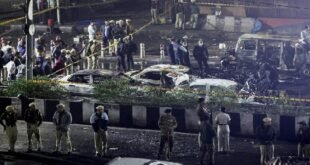30-08-2025
WASHINGTON: Twenty years ago, the floodwalls protecting the city of New Orleans crumbled when Hurricane Katrina made landfall, killing almost 1,500 people.
 Scenes of desperation were broadcast worldwide on August 29, 2005, from across the southern United States city of about 500,000 people, particularly from its inundated and predominantly Black Ninth Ward.
Scenes of desperation were broadcast worldwide on August 29, 2005, from across the southern United States city of about 500,000 people, particularly from its inundated and predominantly Black Ninth Ward.
The storm, which targeted Gulf Coast states and killed more than 1,800 people in total, was the third deadliest hurricane on the US mainland since 1900. It quickly became a mass displacement event often compared to the Great Plains exodus during the 1930s Dust Bowl.
In its wake, Katrina’s generational destruction laid bare stark realities of rampant racial and economic inequality, prompting a passionate if incomplete reckoning over both local policies and national responsibilities to vulnerable communities before and after extreme weather events.
Two decades later, the storm’s legacy continues to haunt many experts in the emergency disaster field, a spectre that has grown larger as many warn the administration of US President Donald Trump may be repeating the same mistakes as it weighs gutting federal capacity.
Alessandra Jerolleman, a director at Loyola University of New Orleans, said Katriana shattered the assumption that Americans would inevitably be protected in times of crisis, laying bare the fragility of the systems meant to safeguard them.
“Katrina laid bare this idea that in an American city, people could be stuck, people could be stranded without basic resources, and the federal government could be too slow and somewhat unable to get people out,” Jerolleman told Al Jazeera.
The head of research at the Center on Environment, Land, and Law, who was living in St Bernard Parish when the hurricane struck, said that this revelation was “very shocking” for many at the time.
 “There were a lot of things that went wrong that really increased the misery that individuals felt,” she said.
“There were a lot of things that went wrong that really increased the misery that individuals felt,” she said.
“And I would be concerned that with a large catastrophic event today, we would be in a similar position.”
A reckoning over emergency response
To be sure, disasters like Katrina can rarely be attributed to a single source, natural or man-made. A confluence of factors and failures including local mismanagement of the city’s flood levees and a poorly planned pre-storm evacuation strategy heightened the storm’s catastrophic might but the bungling response of the Federal Emergency Management Agency (FEMA), a federal agency created in the 1970s to coordinate emergency responses when local and state resources are overwhelmed, has been one of the storm’s most enduring narratives.
“The response to Katrina, I think, woke up a lot of people in the American public about the importance of having a functioning federal government, and particularly a functional emergency management agency in moments of crisis,” said Samantha Montano, an author and associate professor of emergency management at Massachusetts Maritime Academy.
The shock to the national conscience was undergirded by accounts from some of the over 25,000 residents who sought shelter at the New Orleans Superdome.
FEMA employees later testified to Congress about a critical lack of supplies at the facility, which critics say led to dire conditions, including crime, squalor and the suicide of one evacuee who reportedly jumped from a 15-metre (50-foot) walkway in the stadium. (Int’l Monitoring Desk)
 Pressmediaofindia
Pressmediaofindia




